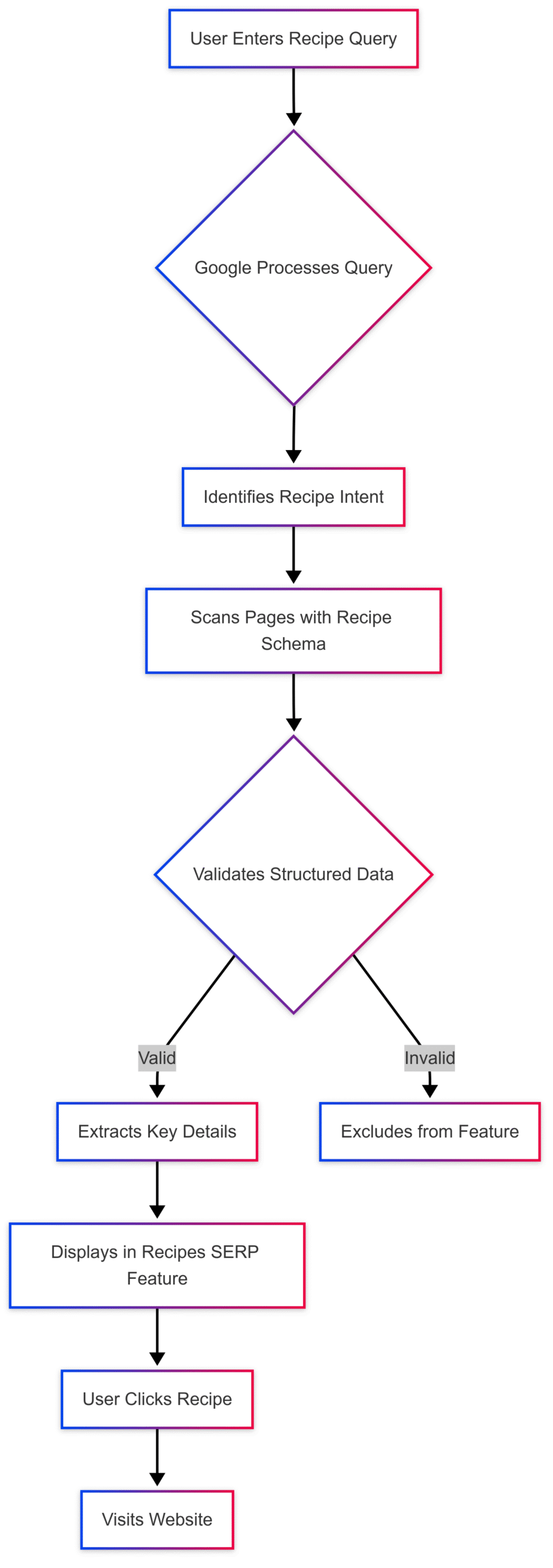How to Rank in Google’s Recipes SERP Feature
In the digital age, food blogs and recipe websites compete fiercely for visibility on Google’s Search Engine Results Pages (SERPs). One of the most effective ways to stand out is by securing a spot in Google’s Recipes SERP feature—a visually rich, interactive display that highlights recipes with images, ratings, and key details like cooking time. This feature, which appears in both Google Search and Google Images, can significantly boost organic traffic, enhance brand visibility, and drive engagement. With recipe searches increasing and the feature appearing 62% more frequently in recent months, optimizing for this SERP feature is a must for food content creators.
This comprehensive guide explores how to rank in Google’s Recipes SERP feature by leveraging structured data, optimizing content, and tracking performance. Whether you’re a food blogger, a culinary brand, or a content marketer, these strategies will help you position your recipes in front of hungry searchers. We’ll cover the technical aspects of structured data, best practices for recipe content, and actionable tips to maximize visibility, complete with examples, charts, and tools to streamline the process.
What is the Recipes SERP Feature?
The Recipes SERP feature is a rich result that Google displays for food-related queries, such as “chicken noodle soup recipe” or “vegan chocolate cake.” It showcases a carousel or grid of recipes, each featuring:
- A high-quality image of the dish
- The recipe name
- The source website
- Star ratings and review counts
- Preparation and cooking times
- Key ingredients or nutritional highlights
On desktop, the feature typically appears as a horizontal carousel with three to four recipe tiles. On mobile, it’s a vertical carousel, often showing more tiles due to the scrolling format. The visual nature of this feature makes it highly engaging, capturing user attention amidst standard search results.
Why It Matters
- Increased Traffic: Recipes in the SERP feature often see higher click-through rates due to their prominent placement and visual appeal.
- Brand Awareness: The feature displays your website’s name, increasing recognition among users.
- Multiple Placements: Your recipe can appear in both the SERP feature and standard organic listings, maximizing exposure.
- Mobile Dominance: The feature appears 50% more frequently on mobile, where most recipe searches occur.
Benefits of Ranking in the Recipes SERP Feature
Securing a spot in the Recipes SERP feature offers several advantages for food blogs and brands:
- Higher Organic Traffic: The feature’s prominent placement—often in positions 1–3—drives more clicks than standard results. Data shows it appears 47% more often in top positions, with 77% of occurrences at position 1.
- Enhanced User Engagement: Visual elements like images and star ratings make your recipe stand out, encouraging users to click and explore your site.
- Brand Exposure: Your website’s name is displayed, fostering familiarity and trust among users.
- Competitive Edge: With recipe searches growing, optimizing for this feature helps you outrank competitors who rely solely on traditional SEO.
- Cross-Platform Visibility: Recipes can appear in Google Search, Google Images, and even host carousels, increasing your reach.
To illustrate the impact, consider this: a food blog optimized for the Recipes SERP feature can see a 1,000%+ increase in traffic compared to relying on social media alone. This makes it a critical strategy for content creators aiming to grow their audience.
When Does the Recipes SERP Feature Appear?
The Recipes SERP feature triggers for queries explicitly related to recipes, such as:
- “Best lasagna recipe”
- “Quick vegan dessert ideas”
- “How to make sourdough bread”
It’s more likely to appear when:
- The query includes terms like “recipe,” “how to make,” or specific dish names.
- The search is performed on mobile, where the feature is 50% more frequent.
- The query targets high-intent recipe searches, such as those tied to holidays (e.g., “Thanksgiving turkey recipe”) or dietary preferences (e.g., “keto breakfast ideas”).
Recent data highlights a 62% increase in the feature’s frequency, reflecting Google’s emphasis on delivering rich, user-friendly results for recipe searches. The feature’s prominence in top SERP positions underscores the importance of optimization.
How the Recipes SERP Feature Works
The Recipes SERP feature relies on structured data—standardized code that helps Google understand and extract key information from your recipe pages. By marking up your content with schema.org properties, you enable Google to display your recipe as a rich result. The primary schema types used are:
- Recipe: Defines individual recipes with details like ingredients, cooking time, and ratings.
- HowTo: Structures step-by-step instructions for preparing the dish.
- ItemList: Summarizes multiple recipes on a single page, enabling carousel or grid displays.
Structured data ensures Google can pull relevant details—such as prep time, calories, or star ratings—and present them in an engaging format. Without proper markup, your recipe is less likely to qualify for the feature, even if it ranks well organically.
Chart: Recipe SERP Feature Workflow

This chart illustrates how Google uses structured data to select and display recipes in the SERP feature, emphasizing the importance of proper markup.
How to Optimize for the Recipes SERP Feature
To rank in the Recipes SERP feature, you need to implement structured data, optimize content, and follow Google’s guidelines. Below is a step-by-step guide to maximize your chances.
1. Implement Structured Data
Structured data is the backbone of the Recipes SERP feature. Use the Recipe schema to mark up individual recipes and ItemList for recipe collections. Here’s how to get started:
Required Properties
- name: The title of the recipe (e.g., “Non-Alcoholic Piña Colada”).
- image: A crawlable, high-resolution image of the dish in .jpg, .png, or .gif format. Provide multiple aspect ratios (16×9, 4×3, 1×1) for flexibility.
- aggregateRating: The average rating and number of reviews (e.g., 5 stars from 18 reviews).
Recommended Properties
- author: The person or organization who created the recipe.
-
prepTime and cookTime: Duration in ISO 8601 format (e.g.,
PT5Mfor 5 minutes). - totalTime: The combined prep and cook time.
- recipeIngredient: A list of ingredients (e.g., “400ml pineapple juice”).
-
recipeInstructions: Step-by-step instructions, preferably using
HowToSteporHowToSection. -
nutrition: Caloric content per serving (requires
recipeYield). - recipeCategory: The meal type (e.g., “dessert”).
- recipeCuisine: The cultural origin (e.g., “American”).
- keywords: Descriptive terms (e.g., “quick, non-alcoholic”).
-
video: A video showing the recipe process, with properties like
contentUrlandthumbnailUrl.
Example: Recipe Structured Data
Below is a JSON-LD example for a non-alcoholic piña colada recipe:
{
"@context": "https://schema.org/",
"@type": "Recipe",
"name": "Non-Alcoholic Piña Colada",
"image": [
"https://example.com/photos/1x1/pina-colada.jpg",
"https://example.com/photos/4x3/pina-colada.jpg",
"https://example.com/photos/16x9/pina-colada.jpg"
],
"author": {
"@type": "Person",
"name": "Mary Stone"
},
"description": "A refreshing non-alcoholic piña colada perfect for all ages.",
"recipeCuisine": "American",
"prepTime": "PT1M",
"cookTime": "PT2M",
"totalTime": "PT3M",
"keywords": "non-alcoholic, tropical, quick",
"recipeYield": "4 servings",
"recipeCategory": "Drink",
"nutrition": {
"@type": "NutritionInformation",
"calories": "120 calories"
},
"aggregateRating": {
"@type": "AggregateRating",
"ratingValue": 5,
"ratingCount": 18
},
"recipeIngredient": [
"400ml pineapple juice",
"100ml cream of coconut",
"ice"
],
"recipeInstructions": [
{
"@type": "HowToStep",
"name": "Blend",
"text": "Blend 400ml of pineapple juice and 100ml cream of coconut until smooth.",
"url": "https://example.com/pina-colada#step1",
"image": "https://example.com/photos/pina-colada/step1.jpg"
},
{
"@type": "HowToStep",
"name": "Fill",
"text": "Fill a glass with ice.",
"url": "https://example.com/pina-colada#step2",
"image": "https://example.com/photos/pina-colada/step2.jpg"
},
{
"@type": "HowToStep",
"name": "Pour",
"text": "Pour the pineapple juice and coconut mixture over ice.",
"url": "https://example.com/pina-colada#step3",
"image": "https://example.com/photos/pina-colada/step3.jpg"
}
]
}Implementing Structured Data
-
Manual Coding: Add JSON-LD or microdata to your HTML. Place JSON-LD in a
<script type="application/ld+json">tag in the<head>or<body>. - CMS Plugins: For WordPress, use plugins like WP Tasty Recipes or Yoast SEO to generate schema markup automatically.
- Tools: Use Schema Builder (a Chrome extension) for a point-and-click interface to create structured data.
Validation
- Test your markup with Google’s Rich Results Test to ensure it’s error-free.
- Use the URL Inspection Tool in Google Search Console to verify Google can crawl and index your page.
- Fix any critical errors and consider addressing non-critical issues to improve quality.
2. Optimize Recipe Content
Beyond structured data, your recipe content must be user-friendly, engaging, and optimized for search intent. Follow these best practices:
Keyword Research
- Use tools like Google Keyword Planner, SEMrush, or Ubersuggest to find relevant keywords with decent search volume and low competition.
- Focus on long-tail keywords (e.g., “low-sugar chocolate lava cake recipe”) to target specific user intents and reduce competition.
- Example: Instead of “cake,” target “vegan gluten-free chocolate cake recipe” for niche audiences.
Content Structure
- Title Tag: Include the primary keyword (e.g., “Easy Chicken Noodle Soup Recipe”).
- Meta Description: Write a compelling description with the keyword (e.g., “Make this easy chicken noodle soup recipe in 40 minutes with simple ingredients.”).
- Headings: Use H1 for the recipe name and H2/H3 for sections like “Ingredients” and “Instructions.”
- Body Content: Integrate keywords naturally in the introduction, ingredients, and steps. Avoid keyword stuffing.
- Ingredients: List precise measurements (e.g., “2 tablespoons olive oil”) and avoid vague terms like “some salt.”
-
Instructions: Use clear, concise steps with bullet points or numbered lists. Group complex recipes into sections (e.g., “Make the Dough,” “Prepare the Filling”) using
HowToSection. -
Images: Include high-quality, descriptive images with keyword-rich file names (e.g.,
vegan-chocolate-cake.jpg) and alt text (e.g., “Vegan chocolate cake with creamy frosting”). - Videos: Embed a recipe video with a keyword-optimized title and description, hosted on YouTube or Vimeo.
Mobile Optimization
- Ensure your website is mobile-friendly, as the Recipes SERP feature appears 50% more often on mobile.
- Use responsive design and compress images with tools like TinyJPG to improve load times.
- Test mobile usability with Google’s Mobile-Friendly Test.
Internal Linking
- Link to related recipes or content clusters (e.g., link a spaghetti recipe to a homemade marinara sauce post).
- Use plugins like Tasty Links to automate internal linking for keywords like “chocolate cake.”
3. Create Recipe Clusters
Recipe clusters group related recipes to boost SEO and user engagement. For example, a “Mediterranean Dishes” cluster could include recipes for hummus, falafel, and tzatziki.
How to Build a Cluster
- Choose a Theme: Select a broad topic (e.g., “Mexican Cuisine”).
- Group Recipes: Include related recipes (e.g., tacos, enchiladas, salsa).
- Interlink: Add links between recipes within the cluster.
-
Create a Summary Page: Build a page listing all recipes in the cluster, marked up with
ItemListschema.
Example: ItemList Structured Data
{
"@context": "https://schema.org",
"@type": "ItemList",
"itemListElement": [
{
"@type": "ListItem",
"position": 1,
"url": "https://example.com/taco-recipe.html"
},
{
"@type": "ListItem",
"position": 2,
"url": "https://example.com/enchilada-recipe.html"
},
{
"@type": "ListItem",
"position": 3,
"url": "https://example.com/salsa-recipe.html"
}
]
}Tools
- Tasty Roundups: Simplifies creating and displaying recipe clusters on WordPress.
- SEMrush: Analyzes competitor clusters to identify gaps.
4. Follow Google’s Guidelines
Adhere to Google’s structured data and content guidelines to avoid penalties:
- General Guidelines: Ensure markup is accurate, relevant, and not spammy. Avoid hidden or misleading data.
-
Recipe-Specific Guidelines: Use
Recipeschema only for edible dishes, not non-food items like “facial scrub.” - Spam Policies: Avoid excessive commentary or keyword stuffing to manipulate rankings.
5. Use Plugins Strategically
Plugins can streamline schema implementation and optimization:
-
WP Tasty Recipes: Automatically generates
Recipeschema and formats recipes for readability. - Yoast SEO or AIOSEO: Optimizes titles, meta descriptions, and overall SEO.
- WP Rocket: Improves site speed, enhancing user experience.
- Tasty Pins: Optimizes images for Pinterest and SEO.
Pricing Example:
- WP Tasty Recipes: $49/year for a single site.
- Yoast SEO Premium: $99/year.
- WP Rocket: $59/year.
- AIOSEO Pro: $199/year.
6. Build Authority
Increase your site’s authority to improve rankings:
- Guest Posting: Write for reputable food blogs and secure backlinks.
- Quality Content: Publish well-researched, unique recipes.
- Backlinks: Earn links from high-authority sites (e.g., food magazines).
- Social Proof: Encourage user reviews and testimonials.
7. Analyze Competitors
Study top-performing food blogs like Pinch of Yum or Serious Eats:
- Identify their top keywords and content formats using SEMrush or Ahrefs.
- Analyze their recipe clusters and internal linking strategies.
- Adapt their successful tactics without copying content.
Tracking Performance with Google Search Console
Once your structured data is live, monitor its performance using Google Search Console:
- Rich Results Status Report: Check for valid and invalid items. Fix errors promptly.
- Performance Report: Track clicks, impressions, and click-through rates for recipe pages.
- URL Inspection Tool: Verify Google can crawl and index your pages.
- Sitemap Submission: Submit an updated sitemap via the Search Console Sitemap API to notify Google of changes.
Combine with Google Analytics to analyze user behavior:
- Bounce Rate: Ensure users stay on your page.
- Time on Page: Confirm engagement with your content.
- Popular Pages: Identify top-performing recipes.
Table: Key Metrics to Track
| Metric | Tool | Purpose |
|---|---|---|
| Clicks | Search Console | Measures traffic from SERP feature |
| Impressions | Search Console | Tracks visibility in search results |
| Click-Through Rate | Search Console | Evaluates user interest |
| Bounce Rate | Google Analytics | Assesses user engagement |
| Time on Page | Google Analytics | Confirms content relevance |
Troubleshooting Common Issues
If your recipe isn’t appearing in the SERP feature, consider these steps:
- Validate Markup: Use the Rich Results Test to identify errors.
- Check Crawlability: Ensure pages aren’t blocked by robots.txt or noindex tags.
- Review Guidelines: Confirm compliance with Google’s policies.
- Allow Time: Re-crawling and indexing can take days.
- Manual Actions: Check for penalties in the Manual Actions Report and resolve spammy markup issues.
- Consult Forums: Post questions in the Google Search Central Forum for community support.
The Recipe Debate: Simplicity vs. Storytelling
A recent discussion on X highlighted a debate among recipe creators: should recipes be stripped-down lists of ingredients and steps, or should they include storytelling and context? Google’s Search Liaison, Danny Sullivan, emphasized that Google aims to serve diverse user preferences. Some users want quick, no-frills recipes, while others value background stories or cultural context.
Key Takeaways
- Balance Simplicity and Depth: Ensure ingredients and instructions are easily accessible (e.g., use a “Jump to Recipe” button), but don’t shy away from storytelling if it adds value.
- User Intent: For quick searches (e.g., “easy dinner recipes”), prioritize concise formats. For niche queries (e.g., “authentic Italian tiramisu”), include cultural details.
- Avoid Fluff: Excessive commentary solely for SEO can frustrate users and hurt rankings.
Tools to Enhance Your Strategy
Leverage these tools to streamline optimization and track performance:
- Google Keyword Planner: Free tool for keyword research.
- SEMrush: $129.95/month for competitor analysis and keyword tracking.
- TinyJPG: Free for compressing images.
- Canva: Free tier for creating infographics and visuals.
- Grammarly: Free for ensuring error-free content.
- Moz: Free tools for checking domain authority.
Conclusion
Ranking in Google’s Recipes SERP feature is a game-changer for food blogs and culinary brands. By implementing structured data, optimizing content for user intent, and tracking performance, you can boost visibility, drive traffic, and build brand loyalty. Focus on creating valuable, engaging recipes that answer specific queries, and use tools like WP Tasty and Google Search Console to simplify the process. With recipe searches on the rise and mobile usage dominating, now is the time to optimize your content and claim your spot in the Recipes SERP feature.
Start by auditing your existing recipes, adding schema markup, and building content clusters. Monitor your progress, refine your strategy, and watch your recipes rise to the top of Google’s results, connecting with food lovers worldwide.
Please share this How to Rank in Google’s Recipes SERP Feature with your friends and do a comment below about your feedback.
We will meet you on next article.
Until you can read, How to Write Sponsored Posts as a Food Blogger






